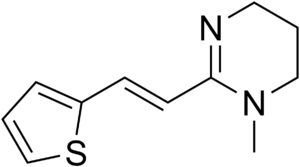Pyrantel
 | |
| Names | |
|---|---|
| Trade names | Pin-X, Combantrin, others[1] |
| |
| Clinical data | |
| Drug class | Antihelmintic[2] |
| Main uses | Parasitic worm infections[3] |
| Side effects | Nausea, headache, dizziness, trouble sleeping[3] |
| Pregnancy category |
|
| Routes of use | By mouth |
| Defined daily dose | 0.75 gram.[4] |
| Typical dose | 10 mg/kg once per day[5] |
| External links | |
| AHFS/Drugs.com | Monograph |
| Chemical and physical data | |
| Formula | C11H14N2S |
| Molar mass | 206.31 g·mol−1 |
| 3D model (JSmol) | |
| Melting point | 178 to 179 °C (352 to 354 °F) |
| |
| |
Pyrantel is a medication used to treat a number of parasitic worm infections.[3] This includes ascariasis, hookworm infections, enterobiasis (pinworm infection), trichostrongyliasis, and trichinellosis.[3] It is taken by mouth.[3]
Side effects include nausea, headache, dizziness, trouble sleeping, and rash.[3] A lower dose should be used in people with liver disease.[3] While it does not appear to be harmful during pregnancy, it has not been studied for this use.[6] It is unclear if it is safe for use during breastfeeding.[3] It is in the antihelmintic family of medications.[2] It works by paralyzing worms.[2]
Pyrantel was initially described in 1965.[7] It is on the World Health Organization's List of Essential Medicines.[8] Pyrantel is available as a generic medication.[2] It costs less than US$25 per course of treatment in the United States.[1] It may also be used to treat worms in a number of other animals.[7]
Medical uses
It is used to treat a number of parasitic worm infections.[3] This includes ascariasis, hookworm infections, enterobiasis (pinworm infection), trichostrongyliasis, and trichinellosis.[3]
Dosage
The defined daily dose is 0.75 gram (by mouth).[4] It is typically used as 10 mg/kg.[5] A single dose is all that is required for ascariasis while a second dose is given after two to four weeks for pin worms.[5] For trichinellosis it is given once per day for five days.[5]
Side effects
Pregnancy and breastfeeding
Pyrantel pamoate is considered a Pregnancy category C drug for use during pregnancy for humans, but is in category A for canines and felines. Pyrantel is considered safe to use in nursing animals.[9]
Mechanism of action
Pyrantel pamoate acts as a depolarizing neuromuscular blocking agent, thereby causing sudden contraction, followed by paralysis, of the helminths. This has the result of causing the worm to "lose its grip" on the intestinal wall and be passed out of the system by natural process. Since Pyrantel is poorly absorbed by the host's intestine, the host is unaffected by the small dosage of medication used. Spastic (tetanic) paralyzing agents, in particular pyrantel pamoate, may induce complete intestinal obstruction in a heavy worm load.[10] This obstruction is usually in the form of a worm impaction and happens when a very small, but heavily parasitized animal is treated and tries to pass a large number of dislodged worms at once. Worms usually pass in normal stool or with diarrhea, straining, and occasional vomiting.
Names
There are a number of brands, including "Reese's Pinworm Medicine", "Pin-X", "Pin-Rid","PYRANTRIN", "COMBANTRIN", "Anthel", "Helmintox", "Helmex", "Strongid" and Drontal Cat.
References
- ↑ 1.0 1.1 Hamilton, Richart (2015). Tarascon Pocket Pharmacopoeia 2015 Deluxe Lab-Coat Edition. Jones & Bartlett Learning. p. 54. ISBN 9781284057560.
- ↑ 2.0 2.1 2.2 2.3 "Pyrantel Pamoate". The American Society of Health-System Pharmacists. Archived from the original on 20 December 2016. Retrieved 8 December 2016.
- ↑ 3.0 3.1 3.2 3.3 3.4 3.5 3.6 3.7 3.8 3.9 World Health Organization (2009). Stuart MC, Kouimtzi M, Hill SR (eds.). WHO Model Formulary 2008. World Health Organization. pp. 89, 608. hdl:10665/44053. ISBN 9789241547659.
- ↑ 4.0 4.1 "WHOCC - ATC/DDD Index". www.whocc.no. Archived from the original on 10 June 2020. Retrieved 21 September 2020.
- ↑ 5.0 5.1 5.2 5.3 "PYRANTEL oral - Essential drugs". medicalguidelines.msf.org. Archived from the original on 29 August 2021. Retrieved 24 August 2020.
- ↑ "Pyrantel Use During Pregnancy | Drugs.com". www.drugs.com. Archived from the original on 20 December 2016. Retrieved 8 December 2016.
- ↑ 7.0 7.1 Maddison, Jill E.; Page, Stephen W.; (BVSc.), David Church (2008). Small Animal Clinical Pharmacology. Elsevier Health Sciences. p. 209. ISBN 978-0702028588. Archived from the original on 2016-12-20.
- ↑ World Health Organization (2019). World Health Organization model list of essential medicines: 21st list 2019. Geneva: World Health Organization. hdl:10665/325771. WHO/MVP/EMP/IAU/2019.06. License: CC BY-NC-SA 3.0 IGO.
- ↑ Plumb, D. C. (2005). Plumb's veterinary drug handbook. Stockholm, Wis: PharmaVet. ISBN 978-0-8138-0518-4.
- ↑ Salman, A. B. (1997). "Management of intestinal obstruction caused by ascariasis". Journal of Pediatric Surgery. 32 (4): 585–587. doi:10.1016/S0022-3468(97)90712-0. PMID 9126759.
External links
| External sites: | |
|---|---|
| Identifiers: |
|
- Pages using duplicate arguments in template calls
- Chemical articles with unknown parameter in Infobox drug
- Chemical articles without CAS registry number
- Articles without EBI source
- Chemical pages without ChemSpiderID
- Chemical pages without DrugBank identifier
- Articles without KEGG source
- Articles without UNII source
- Drugs missing an ATC code
- Drugs with no legal status
- Articles containing unverified chemical infoboxes
- Nicotinic agonists
- Pyrimidines
- Thiophenes
- World Health Organization essential medicines
- RTT